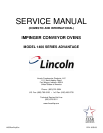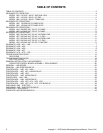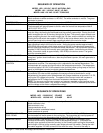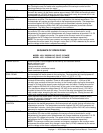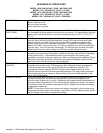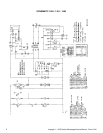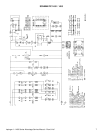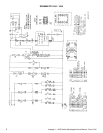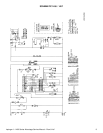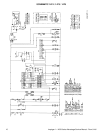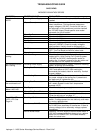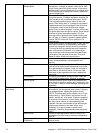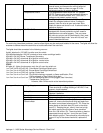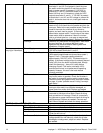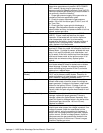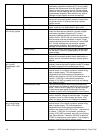
Impinger I – 1400 Series Advantage Service Manual - Dom & Int’l
4
energized, the normally open contacts close, energizing the main fan motor and cooling
fan. Closing the main fan switch also supplies power to the conveyor control and the
centrifugal switch of the main fan motor.
HEAT CIRCUIT Closing the on/off switch supplies 120 VAC to the normally open centrifugal switch (inside
the main fan motor). As the motor reaches approximately (900 RPM) the centrifugal switch
closes supplying 120 VAC through the normally closed oven cavity and control box hi-limit
thermostats, to the electronic temperature control board
TEMPERATURE
CONTROL
When the centrifugal switch (inside the main fan motor) closes, 120 VAC is applied to the
temperature controller. The temperature dial is adjusted to the desired temperature. The
thermocouple will provide varying millivolts to the temperature controller. The temperature
controller supplies 120 VAC to the contactor coils at intermittent intervals (closing the
contactors and supplying 208 or 240 VAC to the heating elements) to maintain desired
temperature. The ready lamp is energized with the contactors.
CONVEYOR DRIVE Closing the on/off switch supplies 120 VAC to the motor control board. AC volts are
converted to DC volts and are supplied to the conveyor motor at terminals A+ and A-.
Adjustment of the speed control potentiometer will change resistance at terminals P1 & P2
varying the DC voltage to the motor. The speed of the conveyor motor will increase or
decrease as the DC voltage from the board increases or decreases respectively.
NOTE: The conveyor control uses a sensor and magnet, mounted on the conveyor motor
that senses the motor speed. Any change in motor load (± RPM) is detected by the sensor
and the voltage to the motor is adjusted accordingly.
SEQUENCE OF OPERATIONS
MODEL 1454 / 380/220 VAC / 50 HZ / 3 PHASE
MODEL 1455 / 415/240 VAC / 50 HZ / 3 PHASE
POWER SUPPLY Electrical power is to be supplied to the oven by a 5-conductor service.
Black conductor is hot.
Red conductor is hot.
Orange conductor is hot.
White conductor is dedicated neutral.
Green conductor is ground
CONTROL BOX AUTO
COOL DOWN
When the temperature in the control box reaches 120°F ± 3°, (49°C ± 1.7°C), the cooling
fan thermostat will switch power to the cooling fan. The thermostat will interrupt power to
the cooling fan when the temperature falls to 100°F ± 3° (37°C ± 1.7°C).
MAIN FAN CIRCUIT Electrical power is permanently supplied through three 50A fuses to the normally open
contacts of the mercury contactor. Power is also supplied through 1, 10A fuse to the
normally open contacts of the main fan relay, to the normally open cooling fan thermostat,
through a 3A fuse to the normally open single pole main fan switch. Closing the main fan
switch supplies 220/240 VAC to the primary of the control circuit step down transformer.
(The transformer steps the voltage down to 120 VAC for the control circuit.) 120 VAC is
supplied to the coil of the main fan relay. The coil of the relay is energized, the normally
open contact close, energizing the main fan motor and cooling fan. Closing the main fan
switch also supplies power to heat and conveyor control.
HEAT CIRCUIT Upon closure of the on/off switch 120 VAC is supplied through the air pressure switch,
through the normally closed oven cavity and control box hi-limit thermostats to the
electronic temperature control.
TEMPERATURE
CONTROL
When 120 VAC is supplied to the temperature controller and the temperature dial is
adjusted to the desired temperature, the thermocouple will provide varying millivolts to the
temperature controller. The temperature controller supplies 120 VAC to the contactor coil
at intermittent intervals, (closing the contactor and supplying 220 or 240 VAC to the heating
elements) to maintain desired temperature.
CONVEYOR DRIVE Closing the on/off switch supplies 120 VAC to the conveyor control board. AC volts are
converted to DC volts and are supplied to the conveyor motor at terminals A+ and A-.
Adjustment of the speed control potentiometer will change resistance at terminals P1 & P2
varying the DC voltage to the motor. The speed of the conveyor motor will increase or
decrease as the DC voltage from the board increases or decreases respectively.
NOTE: The conveyor control uses a sensor and magnet, mounted on the conveyor motor
that senses the motor speed. Any change in motor load (± RPM) is detected by the sensor
and the voltage to the motor is adjusted accordingly.



